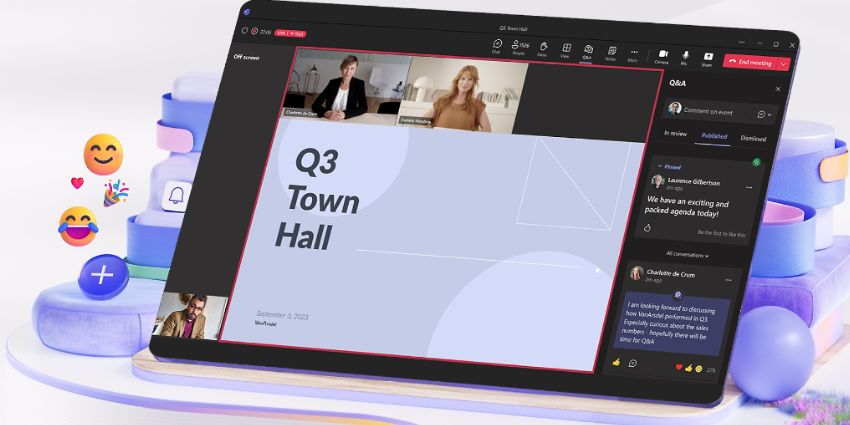“Collaboration” has been an enterprise buzzword for decades, starting with an analog definition — meaning, simply, working on a project with team members — and evolving into something that’s layered with technology. Now, when we say “collaboration,” we usually mean working with team members while using, or inside of, some kind of tech platform — Microsoft Teams, Zoom, Google Meet and so on.
This is especially true in recent months, when many enterprises rapidly shifted to remote-work scenarios due to the pandemic, and collaboration became almost entirely tied to tech platforms. There’s no doubt that what’s occurring right now will impact enterprise technology and operations for years to come — and these are three lessons UC professionals can take from the pandemic.
Don’t assume people don’t want more — or better — office tech
While many enterprises were using collaboration platforms prior to the COVID-19 pandemic, the user base often comprised the more tech-savvy employees, without across-the-board buy-in from all employees in all enterprises.
But the pandemic has proven to be a catalyst for the adoption of collaboration platforms. With the abrupt move to a remote-work model, employees everywhere were forced to become intimately familiar — in some cases overnight — with UC and collaboration technology.
And there’s no turning back now. This move to UC has created a new level of expectation that employees will be able to continue to collaborate from anywhere using these platforms. UC thus will become non-negotiable in the majority of enterprises, even when we return to “normal.”
Don’t underestimate employees’ appetite for technologies that enhance the way they work and make their lives easier — while people can get burned out on tech if there are too many platforms or tools in the mix, with the right solutions, people can quickly adjust and make it part of their workflow.
Reconsider your rollout process
Related to the last point: In our former lives, rolling out new technologies was a lengthy process that took months or even years. Migrating to new platforms involved beta testing different options, selecting small cohorts to test-drive the tech, conducting multiple training sessions, gradually adding technologies by teams or departments, and so forth. It was a slow, straightforward process that allowed people to become more comfortable with different tools during a graduated adoption process.
Then came the coronavirus, and enterprises who had one foot in the world of UC and collaboration tech were pushed headlong into it.
In some cases, IT and UC professionals were given 72 hours to do what they would normally do in 18 months, often cutting out the unnecessary pieces to push out the new tech; some backend transitions began on a Friday night in mid-March and ran nonstop through Monday morning. Employees returned from their weekend (although likely not in person) to a whole new reality. Instead of their learning about new tech via a graduated process, it became the status quo overnight; instead of training sessions led by IT in person, they might have gotten YouTube instructional videos on a private channel.
While this doesn’t sound ideal, people are adaptable, and they’re making it work. Because we’re in extenuating circumstances right now, most employees understand they aren’t going to have their hands held the way they normally would during a transition to new tech. (When you go to a Waffle House right after a hurricane, you don’t complain that they’re only serving a limited menu!)
The way this has been navigated may indicate that we don’t need to allow as much time for some (not all) rollouts as we have been allocating. While something like a cloud migration will continue to be a massive undertaking for a while yet, rolling out new UC platforms — especially ones designed to be intuitive and user friendly — with a shortened timeline might prove to be more effective for getting everyone on board. When people absolutely have to use something, they’ll learn it faster.
If you didn’t have a plan for a widespread remote work transition, make one (it’s not too late)
And don’t feel too badly if you didn’t have a plan, either — there are plenty of companies who hadn’t thought much about their mobile device policies or remote work plans up until March or April of this year, and had to do everything on the fly.
That doesn’t mean it’s too late to design concrete plans and policies around remote collaboration. Whether you had an existing plan or not, take time to think about what’s working and what’s not with your current work environment. Use the lessons learned from this forced shift in work locations and devices to create a well-vetted plan for a large-scale remote work scenario.
On a basic level, this means establishing solid management and communications practices within an organization, so people understand not just what UC tools they should have on their devices, but also what’s expected of them, where they can go for resources or help, what security protocols they must follow, and so forth.
On a more advanced level, this means ensuring employees have the right devices and technologies to do their jobs both from the office and at home. Considering that most companies will be dealing with both scenarios of a significantly reduced work force in their offices and a remote work force at any given time, collaboration technology needs to not only be accessible from home but rolled into every possible meeting space as quickly as possible.
Organizations are turning to their non-traditional spaces – such as lobbies or hallways – to host larger meetings as a result of social distancing guidelines. Enterprises will still need the right equipment to host calls so non-permanent conferencing tools will be introduced into the office. These tools can be moved around and installed easily.
Collaboration platforms are here to stay
It’s hard to imagine a pandemic scenario where we would be able to work without enterprise-grade collaboration platforms — they’re literally keeping companies afloat right now. And even when enterprise workforces move back into an office space, it’s hard to imagine going back to a meeting room that contains only a white board and conference room table in it when half of your team is still working at home. Technology is now a requirement, the bar has been set higher, and people will expect to continue using the powerful tools they’ve been relying on during the transition to remote work.
We have crossed the tipping point for collaboration platforms and technology, and there’s no going back.
Guest Blog by Joe Sarrasin, Unified Communications Strategy Director at Crestron
Joseph Sarrasin is the Unified Communications Strategy Director for Crestron, a leader in workplace technology. Joe has been working at Crestron since July 2014 and leads the company’s overall product strategy and direction for UC. Prior to joining Crestron, he has held positions with ESPN and Teliris Inc. Joe holds a Bachelor of Science degree in Electronic Media, Arts, and Communications from Rensselaer Polytechnic Institute Degree and a Masters in Business Administration from the University of Massachusetts at Amherst.







